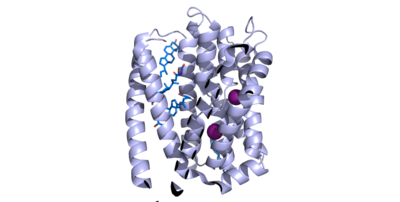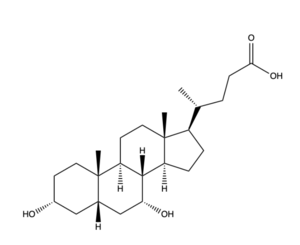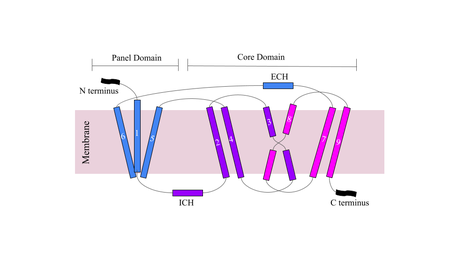Sandbox Reserved 1783
From Proteopedia
(Difference between revisions)
| (10 intermediate revisions not shown.) | |||
| Line 22: | Line 22: | ||
=== Binding Pocket === | === Binding Pocket === | ||
| - | <scene name='95/952711/Sodium_residue_zoom_in_nctp/ | + | <scene name='95/952711/Sodium_residue_zoom_in_nctp/5'>Each sodium binds to a specific set of residues</scene>. Sodium 1 interacts mainly with residues 105, 106, 123, and 257. Sodium 2 interacts mainly with residues 68 and 261. <Ref name="Goutam"> Goutam, K., Ielasi, F.S., Pardon, E. et al. The binding pocket forms a tunnel structure within NTCP at the interface of two domains that connects the external cytoplasm of the hepatocyte to the basolateral membrane. The face of the tunnel where the bile salts bind is lined with hydrophilic residues, whereas the opposite face of the transmembrane helices is hydrophobic, making the tunnel amphipathic. <Ref name="Liu"> Liu, H., Irobalieva, R.N., Bang-Sørensen, R. et al. The structure of human NTCP reveals the basis of recognition and sodium-driven transport of bile salts into the liver. Cell Res 32, 773–776 (2022). [https://doi.org/10.1038/s41422-022-00680-4 DOI: 10.1038/s41422-022-00680-4]. </Ref> The hydrophilic tunnel allows hydrophilic bile salts and sodium ions to be transported across the hydrophobic cell membrane. In the <scene name='95/952711/Tunnel_front/1'>outward facing state</scene> with no bile salt bound to the tunnel, it forms a hollow hole in the middle of the structure. When bile salts bind within, these bile salts completely occlude the <scene name='95/952711/Bile_bound_to_tunnel/1'>tunnel</scene>. |
=== Conformation Change === | === Conformation Change === | ||
| - | The conformational change of NTCP's core domain helices | + | The conformational change of NTCP's core domain helices is essential to bile salt binding and uptake. Helices 3 and 8 <scene name='95/952711/X_motif/3'>X motif</scene> are the main structural components of the conformational change, as the X motif has highly conserved polar residue motifs that reside near the bile salt transport sites. The conformational change is energized by the movement of Na+ down its concentration gradient. Before bile salt can bind, the pore in which salt binds must be <scene name='95/952711/Open_pore_ntcp_non_transparent/3'>open</scene>. Conserved glycine and proline residues act as hinges in the connecting short loops, intracellular α-helix, and extracellular α-helix of NTCP to facilitate the movement of the core and panel domain to allow for a conformational change. The <scene name='95/952711/Open_pore_ntcp/3'>open</scene> pore is flipped toward the outer membrane to allow for bile salt binding by exposing the Na+ binding sites and the X motif within NTCP. Once <scene name='95/952711/Open_pore_with_bile_salts/4'>bound</scene>, the pore is <scene name='95/952711/Closed_pore_ntcp/3'>closed</scene>, and bile salt is able to be released into the cell, past the inner membrane. <ref name="Goutam"/> |
=== Mechanism === | === Mechanism === | ||
| Line 33: | Line 33: | ||
[[Image:Screenshot_2023-04-10_at_4.18.47_PM.png|400 px|right|thumb|'''Figure 4.''' Bile Salt Uptake Mechanism: Conformational Change. This change in structure aids in the uptake of bile salts. The core domain is shown in pink, and the panel domain is light blue. The dark blue structure is bile salt. When the pore is "open," both the core and panel domains are open to the extracellular side. When the pore is "closed," the domains are open to the intracellular space.]] | [[Image:Screenshot_2023-04-10_at_4.18.47_PM.png|400 px|right|thumb|'''Figure 4.''' Bile Salt Uptake Mechanism: Conformational Change. This change in structure aids in the uptake of bile salts. The core domain is shown in pink, and the panel domain is light blue. The dark blue structure is bile salt. When the pore is "open," both the core and panel domains are open to the extracellular side. When the pore is "closed," the domains are open to the intracellular space.]] | ||
| - | The NTCP protein goes through a conformational change when assisting in the uptake of bile salt into the cell. This is accomplished through the opening of a wide transmembrane pore, creating a transport pathway for bile salts. The mechanism includes two <scene name='95/952711/1_sodium_binding_to_ntcp/ | + | The NTCP protein goes through a conformational change when assisting in the uptake of bile salt into the cell. This is accomplished through the opening of a wide transmembrane pore, creating a transport pathway for bile salts. The mechanism includes two <scene name='95/952711/1_sodium_binding_to_ntcp/3'>sodim</scene> metal ions that allow for residue stabilization when going through the conformational change. The binding of the preS1 region of the HBV/HDV virus blocks any subsequent bile salt uptake. Thus, preS1 binding blocks the conformational change and entry of any salts into the cell. Residues 8-17 of preS1 are critical for NTCP:pres1 binding. Patch 1 and Patch 2 (external) residues interact with residues 8-17 of preS1 to facilitate binding. |
== Significance == | == Significance == | ||
| Line 47: | Line 47: | ||
== References == | == References == | ||
<references/> | <references/> | ||
| + | |||
| + | == Student Contributors == | ||
| + | |||
| + | Olivia Simcox, Tatiana Pereda, and Kenna King; Butler University, April 2023 | ||
Current revision
| This Sandbox is Reserved from February 27 through August 31, 2023 for use in the course CH462 Biochemistry II taught by R. Jeremy Johnson at the Butler University, Indianapolis, USA. This reservation includes Sandbox Reserved 1765 through Sandbox Reserved 1795. |
To get started:
More help: Help:Editing |
Sodium Taurocholate Co-Transporting Peptide
| |||||||||||
References
- ↑ 1.0 1.1 1.2 1.3 1.4 1.5 Goutam, K., Ielasi, F.S., Pardon, E. et al. Structural basis of sodium-dependent bile salt uptake into the liver. Nature 606, 1015–1020 (2022). DOI: 10.1038/s41586-022-04723-z.
- ↑ Maldonado-Valderrama, J., Wilde, P., Macierzanka, A., & Mackie, A. (2011). The role of bile salts in digestion. Advances in colloid and interface science, 165(1), 36–46. DOI: 10.1016/j.cis.2010.12.002.
- ↑ 3.0 3.1 Asami J, Kimura KT, Fujita-Fujiharu Y, Ishida H, Zhang Z, Nomura Y, Liu K, Uemura T, Sato Y, Ono M, Yamamoto M, Noda T, Shigematsu H, Drew D, Iwata S, Shimizu T, Nomura N, Ohto U. Structure of the bile acid transporter and HBV receptor NTCP. Nature. 2022 Jun; 606 (7916):1021-1026. DOI: 10.1038/s41586-022-04845-4.
- ↑ Xiangbing Qi, Wenhui Li. (2022). Unlocking the secrets to human NTCP structure. The Innovation, Vol. 3, Issue 5. 100294, ISSN 2666-6758, DOI: 10.1016/j.xinn.2022.100294.
- ↑ Vlahcevic, Z., Buhac, I., et al. Bile Acid Metabolism in Patients with Cirrhosis. Gastroenterology vol. 60, 491-498 (1971). DOI: 10.1016/S0016-5085(71)80053-7.
Student Contributors
Olivia Simcox, Tatiana Pereda, and Kenna King; Butler University, April 2023




